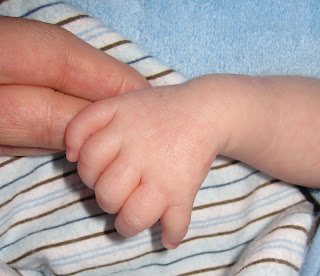Radial Longitudinal Deficiency (RLD) has a wide range of presentations from a small, unstable thumb to major bone and soft tissue problems of the entire upper extremity. And yet, despite this wide range, most kids have a somewhat predictable appearance within a couple of different categories. I have shared my thoughts on these variations HERE, numerous posts included.
We have a large group of patients that we follow with RLD and, therefore, we see some kids that fall outside that ‘typical’ group (for this very unusual problem). This is one such child.
 |
| Left wrist in radial longitudinal deficiency. Note the flexed and deviated position of the wrist. Also, there are only 4 fingers. |
 |
| Right wrist in radial longitudinal deficiency. While the wrist is slightly deviated, the major issue is the thumb. |
His right forearm is relatively normal but his hand is not. He has an unusual type of hypoplastic or underdeveloped thumb. The web space between the thumb and index finger is very small. This is a key factor for function including grasping large objects. He was treated surgically to widen the space, stabilize the thumb, and provide a new muscle for thumb strength.
 |
| Hypoplastic thumb with very small web space. |
 |
| Hypoplastic thumb with very small web space, view from palm. |
 |
| Large dorsal flap designed to maximally widen the web space in the hypoplastic thumb. |
 |
| View of the hypoplastic thumb immediately after surgery |
 |
| Another view of the hypoplastic thumb after reconstruction. |
The left upper extremity was a bit more of a challenge as the forearm was affected- a type IV radial longitudinal deficiency– and the hand was affected as well. The thumb was also affected in a very unusual way- the index finger and the thumb were fused.
 |
| Type 4 Radial Longitudinal Deficiency with absent radius and unusual, fused thumb and index finger. |
The first step for us was to address the forearm. The patient did not have a radius or any of the radial sided muscles. We therefore chose a centralization procedure (again, see previous posts
HERE) with a fixator to stretch the tight structures.
 |
| Here is the fixator just before removal in radial longitudinal deficiency. Note how straight the wrist has become. |
 |
| Radial longitudinal deficiency after fixator removal. |
 |
| Radial longitudinal deficiency after fixator removal and after centralization. Note the straight wrist. |
Here is the wrist position about 6 months later. Note that the wrist remains straight. Also note, the position of the thumb which is a real challenge. It has little movement.
 |
| Radial longitudinal deficiency after centralization. The thumb remains a challenge. |
The extra thumb bones were removed to increase the chance of useful thumb motion and the thumb was repositioned.
Here are our most recent pictures showing hands and thumbs that are in an improved and more functional position. The family is pleased with function and appearance.
 |
| Patient appearance after right thumb reconstruction and left wrist and thumb reconstruction for radial longitudinal deficiency. |
 |
| The patient does use the thumb even though it remains stiff. Thumb function after reconstruction for radial longitudinal deficiency and thumb deficiency. |
While this is an unusual type of radial longitudinal deficiency, the basic principles of our care program are applied. We work with the family to develop a plan to maximize function and minimize the number of surgeries required. We will follow the patient over many years to observe function and use therapy as necessary if functional limitations are demonstrated. We do not expect he will need additional surgery, but we will follow him to observe his development and limitations.
Charles A. Goldfarb, MD
My Bio at Washington University
congenitalhand@wudosis.wustl.edu














In reviewing the posts for radial deficiencies, most seem to be on the more sever end of the spectrum with missing radius etc. Could you comment on, or are there any blog posts, for what the typical course of treatment is when the radius is only slightly shorter than the ulna?
I do need to post more on Type I and II radial deficiency. Typically, the wrist rests in a straighter (if not straight) position and if anything needs to be done for the wrist, a tendon balancing surgery can help. There can still be muscle limitations in the forearm and there can still be thumb limitations.
Please help. I think my son has a hypoplastic thumb. What are the results of reconstruction? If his is a type 1 or 2
Helena,
I have been very pleased with surgical reconstruction. We don't typically perform surgery for type 1 (a somewhat small thumb that is otherwise structurally normal) but surgery can be very helpful for strength and stability in type 2. I hope that is helpful.